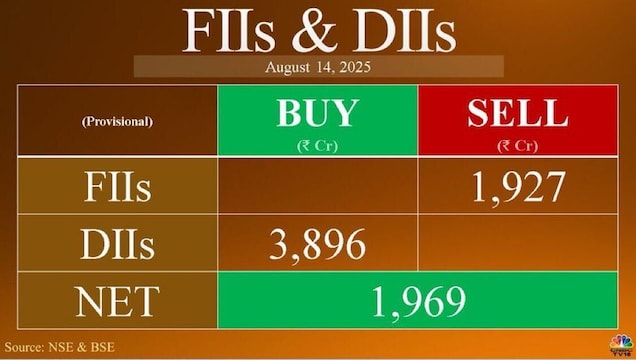The Indian equity markets opened the truncated trading week on a strong note, snapping their streak of weekly losses. Although momentum slowed in the latter half, the indices managed to hold on to higher levels.
By the close, the benchmark index gained over 1%, reclaiming the 24,600 mark on a weekly basis.
The Nifty 50, however, remained lackluster, trading in a narrow range ahead of the Trump-Putin meeting on Friday. On Thursday, the index saw choppy action for the second session in a row. After a flat-to-positive start, it oscillated within a tight 76-point band through the day, before ending just 11 points higher at 24,631.
Going forward, key breakout levels at 24,800 on the upside and 24,400 on the downside will guide the next move.
Broader markets underperformed, with the Nifty Midcap slipping 0.7% and Smallcap down 0.6%.In the primary market, JSW Cement made a volatile debut on August 14. The stock opened at ₹153.5 on the NSE, a 4.4% premium to its issue price, and hit an intraday high of ₹154.77 before slipping to a low of ₹145.05. It traded rangebound for most of the session and finally closed 0.63% lower, with volumes of 10.5 crore shares on the NSE and 1.11 crore on the BSE. The decline was likely due to concerns over rich valuations.
On the global front, the US imposed an additional 25% tariff on certain Indian exports, though existing exemptions were retained.
Back home, the focus remained on the Q1FY26 earnings season. While overall results were largely in line with expectations, muted management commentary led to further earnings downgrades.
Foreign Portfolio Investors (FPIs) continued to hold large short positions, keeping market sentiment cautious and heightening the risk of volatility and sell-on-rise trades. At the same time, expectations of changes in the GST structure could provide some relief in the near term.
Despite supportive factors such as the lowest CPI reading in months and record mutual fund inflows, markets stayed trapped in a narrow range last week, reflecting a lack of clear direction. Traders are now likely to take cues from updates at the September GST Council meeting.
Meanwhile, on Thursday, foreign investors were net sellers in the cash market, while domestic investors stepped in as net buyers.

Technically, the market action indicates range-bound movement, with participants possibly awaiting key geopolitical events over the long weekend, said Nagaraj Shetti of HDFC Securities.
According to Shetti, the Nifty on the weekly chart formed a reasonably positive candle, reversing the previous six weeks of losses. The presence of cluster supports around the 24,300-24,200 zone could act as a strong cushion against any weakness.
However, a sustained move above the 24,700 hurdle may pave the way for further upside towards the 25,000 mark in the near term, he added.
Rupak De of LKP Securities said that sentiment is likely to favour bullish trades as long as the index holds above 24,337.“On the higher side, resistance is placed at 24,660 and 24,850, while a fall below 24,337 could trigger a resumption of the bearish trend,” he said.
From a technical perspective, the Nifty50 has successfully reclaimed the 100-DEMA and halted its losing streak. Nevertheless, it remains subdued in anticipation of significant geopolitical developments over the long weekend, said Rajesh Bhosale of Angel One.
At this stage, the 24,650-24,750 range represents a formidable barrier. A decisive breakout above this level could trigger a fresh phase of momentum in the coming week, potentially opening the path towards 25,000.
On the downside, 24,500 is expected to offer initial support, with a critical support zone placed between 24,400-24,350, Bhosale added.
